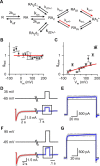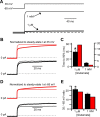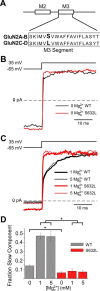Mechanistic and structural determinants of NMDA receptor voltage-dependent gating and slow Mg2+ unblock
- PMID: 23447622
- PMCID: PMC3629906
- DOI: 10.1523/JNEUROSCI.3712-12.2013
Mechanistic and structural determinants of NMDA receptor voltage-dependent gating and slow Mg2+ unblock
Abstract
NMDA receptor (NMDAR)-mediated currents depend on membrane depolarization to relieve powerful voltage-dependent NMDAR channel block by external magnesium (Mg(o)(2+)). Mg(o)(2+) unblock from native NMDARs exhibits a fast component that is consistent with rapid Mg(o)(2+) -unbinding kinetics and also a slower, millisecond time scale component (slow Mg(o)(2+) unblock). In recombinant NMDARs, slow Mg(o)(2+) unblock is prominent in GluN1/2A (an NMDAR subtype composed of GluN1 and GluN2A subunits) and GluN1/2B receptors, with slower kinetics observed for GluN1/2B receptors, but absent from GluN1/2C and GluN1/2D receptors. Slow Mg(o)(2+) unblock from GluN1/2B receptors results from inherent voltage-dependent gating, which increases channel open probability with depolarization. Here we examine the mechanisms responsible for NMDAR subtype dependence of slow Mg(o)(2+) unblock. We demonstrate that slow Mg(o)(2+) unblock from GluN1/2A receptors, like GluN1/2B receptors, results from inherent voltage-dependent gating. Surprisingly, GluN1/2A and GluN1/2B receptors exhibited equal inherent voltage dependence; faster Mg(o)(2+) unblock from GluN1/2A receptors can be explained by voltage-independent differences in gating kinetics. To investigate the absence of slow Mg(o)(2+) unblock in GluN1/2C and GluN1/2D receptors, we examined the GluN2 S/L site, a site responsible for several NMDAR subtype-dependent channel properties. Mutating the GluN2 S/L site of GluN2A subunits from serine (found in GluN2A and GluN2B subunits) to leucine (found in GluN2C and GluN2D) greatly diminished both voltage-dependent gating and slow Mg(o)(2+) unblock. Therefore, the residue at the GluN2 S/L site governs the expression of both slow Mg(o)(2+) unblock and inherent voltage dependence.
Figures








Similar articles
-
Voltage-dependent gating of NR1/2B NMDA receptors.J Physiol. 2008 Dec 1;586(23):5727-41. doi: 10.1113/jphysiol.2008.160622. Epub 2008 Oct 20. J Physiol. 2008. PMID: 18936081 Free PMC article.
-
NMDA receptor NR2 subunit dependence of the slow component of magnesium unblock.J Neurosci. 2006 May 24;26(21):5825-34. doi: 10.1523/JNEUROSCI.0577-06.2006. J Neurosci. 2006. PMID: 16723541 Free PMC article.
-
A single GluN2 subunit residue controls NMDA receptor channel properties via intersubunit interaction.Nat Neurosci. 2012 Jan 15;15(3):406-13, S1-2. doi: 10.1038/nn.3025. Nat Neurosci. 2012. PMID: 22246434 Free PMC article.
-
Molecular bases of NMDA receptor subtype-dependent properties.J Physiol. 2015 Jan 1;593(1):83-95. doi: 10.1113/jphysiol.2014.273763. Epub 2014 Sep 9. J Physiol. 2015. PMID: 25556790 Free PMC article. Review.
-
Structural insights into gating mechanism and allosteric regulation of NMDA receptors.Curr Opin Neurobiol. 2023 Dec;83:102806. doi: 10.1016/j.conb.2023.102806. Epub 2023 Nov 9. Curr Opin Neurobiol. 2023. PMID: 37950957 Review.
Cited by
-
Glutamate receptor pores.J Physiol. 2015 Jan 1;593(1):49-59. doi: 10.1113/jphysiol.2014.272724. Epub 2014 May 6. J Physiol. 2015. PMID: 25556787 Free PMC article. Review.
-
Ionotropic glutamate receptors: alive and kicking.J Physiol. 2015 Jan 1;593(1):25-7. doi: 10.1113/jphysiol.2014.284448. J Physiol. 2015. PMID: 25556784 Free PMC article. No abstract available.
-
The NMDA receptor regulates integrin activation, ATP release and arterial thrombosis through store-operated Ca2+ entry in platelets.Front Cardiovasc Med. 2023 May 12;10:1171831. doi: 10.3389/fcvm.2023.1171831. eCollection 2023. Front Cardiovasc Med. 2023. PMID: 37252113 Free PMC article.
-
NMDA receptors: linking physiological output to biophysical operation.Nat Rev Neurosci. 2017 Mar 17;18(4):236-249. doi: 10.1038/nrn.2017.24. Nat Rev Neurosci. 2017. PMID: 28303017 Free PMC article. Review.
-
The Progress of Cognitive Dysfunction Impairment Caused by Temporal Lobe Epilepsy.J Mol Neurosci. 2025 Jun 21;75(3):81. doi: 10.1007/s12031-025-02365-0. J Mol Neurosci. 2025. PMID: 40542997 Free PMC article. Review.
References
-
- Antonov SM, Gmiro VE, Johnson JW. Binding sites for permeant ions in the channel of NMDA receptors and their effects on channel block. Nat Neurosci. 1998;1:451–461. - PubMed
Publication types
MeSH terms
Substances
Grants and funding
LinkOut - more resources
Full Text Sources
Other Literature Sources
